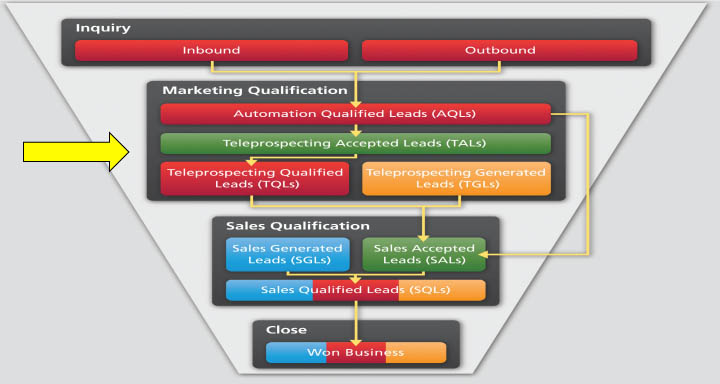 In the previous four posts on the importance of multi-touch lead nurturing, we discussed what it takes to deliver a qualified, sales-ready lead. In summary, we said:
In the previous four posts on the importance of multi-touch lead nurturing, we discussed what it takes to deliver a qualified, sales-ready lead. In summary, we said:
- Marketing is now required to generate more of the higher quality sales-ready leads defined by the sales organization.
- This isn’t easy to do. Marketing automation can’t make it happen alone.
- You’re going to have to plan for multiple touches and multiple channels unique to each market and buying conditions.
- To shorten the process: have a comprehensive plan, targeted lists, segmented messaging, compelling offers, great creative (email, direct mail, etc.), a plan for personal touches (tele-prospecting)—and track the metrics so you can adjust.
- We also said that marketing must take over the job of pre-qualifying leads. The leads that come in from marketing automation software or over-the-transom inquiries simply do not contain the level of data that Sales requires to justify their limited time and sales resources.
In this post, we’re we'll take a look at a real-world scenario in which a major manufacturer of industrial gloves put these principles into action and reaped the benefits.
RELATED CLASS: How To Understand Your Buyers: 5 Insights for Better B2B Marketing
Multi-Touch Lead Nurturing Case Study: Glove Manufacturer
The ABC Glove Corporation (not the real name—we can’t reveal it in this post) is a leader in the field of industrial gloves. The average value of a new customer account to ABC is high—around $50,000 per customer per year. The target contact is a decision maker in safety, operations or purchasing within metal manufacturing industries.
ABC’s ambitious goal was to gain $2.5 million in incremental sales. The corporation’s marketing department tried everything: pay-per-click advertising, email, tradeshows and more—but could not acquire enough qualified sales leads to hit this target. ABC called us in to help them take a fresh and more productive approach.
RELATED CLASS: Enterprise Sales Predictions: How to Use Big Data to Predict Sales & Increase Revenue
First, we identified the “sales-ready A lead” criteria based on their selling process and marketplace. Then we did some simple, back-of-the-napkin analysis of the needs of the lead-to-sales funnel. Based on the estimations of the vice president of marketing, we found that achieving an incremental $2.5 million in annual sales at $50,000 per sale meant they would have to close 50 new sales in a year. At a 20% proposal close rate, they needed 250 qualified sales opportunities in the proposal stage. At a 25% conversion rate (qualified sales-ready A leads to proposal rate), ABC needed 1,000 “Qualified A” leads in the sales team pipeline. And the conversion rate of marketing inquiry level (MQL) leads to sales-ready A leads is 10%. The bottom line: ABC Corporation needed 10,000 MQLs in the top of the demand generation funnel process to be able to hit their incremental sales target.
Why wouldn't email alone work?
The VP of marketing estimated that on the high end, the available universe of companies in metal manufacturing was roughly 7,500. If ABC emailed all 7,500 and got a 1% inbound response, that would equal 75. If 50% of those leads filled out a form, that would result in 35 marketing-level MQL leads and only 7.5 Sales-ready A leads. ABC would have to email to this list at least 285 times to get the 10,000 marketing-level leads in the pipeline. (But it is unlikely that every email would result in a 1% inbound response as the response rates from this small audience would decline over time.)
So email alone could not achieve the sales goals.
Multi-Touch and Multi-Channel Solution
Under the conditions of this small but highly valuable target market, we determined that ABC needed a much higher lead-to-sale conversion process to meet their sales goals. We recommended a multi-touch and multi-channel sequence of email and tele-prospecting with comprehensive metrics benchmarking.
RELATED CLASS: How to Setup a Lead Management Process
We normally recommend testing different approaches with a small sample of prospects to see which approach stimulates the highest response level. In this case, we tested two offers: a book about physical safety in the metal manufacturing environment versus the offer of a free pair of gloves. The VP of marketing suggested the offer of a free pair of gloves because in his experience, the prospect would request a sample pair in any case, so he felt this would short-circuit the process to some degree. We were less certain, as we have found in the past that a free sample sometimes feels like too much of a commitment early in the relationship. We also tested two lists, an in-house list versus a rental list.
The test showed that the appeal of the offer was about equal between the gloves and the book. We went with the gloves for the final campaign because sooner or later, the prospect would request a free pair of gloves anyway. Both lists performed equally well.
The multi-touch lead nurturing process involved:
- Initial email campaign
- Initial call (left voice message or in some accounts we must be directed to proper contact)
- Call to engage new contact in the value prop and offers
- Email to correct contact, and or email content as requested to support our dialog
- Call to complete the value prop and offer conversation, listen to needs and pain points and gather those critical data points into the lead qualification script-record, and if qualified, close on ABC sales rep appointment
Remember that we have been saying it takes seven to 13-plus touches to deliver a sales-ready lead? In this case, the average number of touches was 4.28. Why did our campaign for ABC require so few touches? The answer is embedded in what we’ve been saying all along:
- Have a good list (few incorrect contacts)
- Develop creative that captures hearts and minds and have follow up content and dialog to support it
- Offer something of high perceived value
- Optimize the value proposition delivery by adding teleprospecting to the mix. This creates a personal relationship with the prospect. Remember: people buy from people, and prospects don’t share their qualifying pain points online.
While we can’t share final numbers for incremental sales for this client, we do know that the client’s sales team is delighted with the results and they are continuing to implement our multi-touch, multi-channel approach.
Learn how to nurture more leads to qualified with an effective marketing automation program.
Watch Marketing Automation Best Practices for Success, and get expert advice to build your case for marketing automation, select the right solution, develop the right people with the right skills, and define your implementation strategy. Get instant access to this class now.
